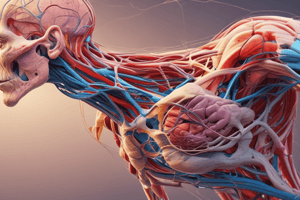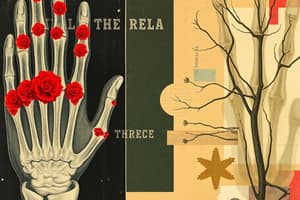Podcast
Questions and Answers
The radial nerve originates from the _________ cord(s).
The radial nerve originates from the _________ cord(s).
- Posterior cord (correct)
- Lateral cord
- Medial cord
The ulnar nerve originates from the __________ cord(s)
The ulnar nerve originates from the __________ cord(s)
- lateral cord
- medial cord (correct)
- posterior cord
- all of the above
Which nerve is compressed in Guyon Tunnel/Canal Syndrome?
Which nerve is compressed in Guyon Tunnel/Canal Syndrome?
- Axillary Nerve
- Median Nerve
- Radial Nerve
- Ulnar Nerve (correct)
Which muscle is inserted onto the Palmar Aponeurosis?
Which muscle is inserted onto the Palmar Aponeurosis?
What is the nerve supply to the Flexor Digitorum Profundus?
What is the nerve supply to the Flexor Digitorum Profundus?
Where does the extensor carpi radialis longus insert?
Where does the extensor carpi radialis longus insert?
What action does the Opponens Pollicis perform?
What action does the Opponens Pollicis perform?
Where will a patient point to pain regarding tennis elbow?
Where will a patient point to pain regarding tennis elbow?
Which muscle is not part of the rotator cuff?
Which muscle is not part of the rotator cuff?
What is the most often injured muscle of the rotator cuff?
What is the most often injured muscle of the rotator cuff?
Which nerve innervates the latissimus dorsi muscle?
Which nerve innervates the latissimus dorsi muscle?
Which artery is a branch of the second part of the axillary artery?
Which artery is a branch of the second part of the axillary artery?
What is the lateral boundary of the cubital fossa?
What is the lateral boundary of the cubital fossa?
What passes through the quadrangular space?
What passes through the quadrangular space?
Which nerve is affected in 'Winging of the scapula'?
Which nerve is affected in 'Winging of the scapula'?
Which muscle is not a rotator cuff muscle?
Which muscle is not a rotator cuff muscle?
What is the most commonly fractured carpal bone?
What is the most commonly fractured carpal bone?
What veins come together to form the axillary vein?
What veins come together to form the axillary vein?
What is the origin of the musculocutaneous nerve?
What is the origin of the musculocutaneous nerve?
Which artery is a branch of the second part of the axillary artery?
Which artery is a branch of the second part of the axillary artery?
What is the continuation of the basilic vein?
What is the continuation of the basilic vein?
Which muscle does not attach to the coracoid process of the scapula?
Which muscle does not attach to the coracoid process of the scapula?
What is the lateral boundary of the cubital fossa?
What is the lateral boundary of the cubital fossa?
What nerve is affected in 'Winging of the scapula'?
What nerve is affected in 'Winging of the scapula'?
What is the most commonly fractured carpal bone?
What is the most commonly fractured carpal bone?
Which veins come together to form the axillary vein?
Which veins come together to form the axillary vein?
What nerve is compressed in Pronator Teres Syndrome?
What nerve is compressed in Pronator Teres Syndrome?
Which muscle is supplied by the radial nerve?
Which muscle is supplied by the radial nerve?
What is the nerve supply to the Flexor Digitorum Superficialis?
What is the nerve supply to the Flexor Digitorum Superficialis?
Where does the Extensor Pollicus Longus travel through?
Where does the Extensor Pollicus Longus travel through?
Which muscle is a medial rotator of the shoulder?
Which muscle is a medial rotator of the shoulder?
What is the most often injured muscle of the rotator cuff?
What is the most often injured muscle of the rotator cuff?
What travels through the quadrangular space?
What travels through the quadrangular space?
Damage to which nerve causes winged scapula?
Damage to which nerve causes winged scapula?
The musculocutaneous nerve is a branch of which cord?
The musculocutaneous nerve is a branch of which cord?
Which vein is a continuation of the basilic vein?
Which vein is a continuation of the basilic vein?
Which muscle has an insertion on the coracoid process of the scapula?
Which muscle has an insertion on the coracoid process of the scapula?
Which artery divides the quadrangular space from the triangular space?
Which artery divides the quadrangular space from the triangular space?
Which nerve innervates the latissimus dorsi muscle?
Which nerve innervates the latissimus dorsi muscle?
What is the lateral boundary of the cubital fossa?
What is the lateral boundary of the cubital fossa?
Which nerve is affected in 'Winging of the scapula'?
Which nerve is affected in 'Winging of the scapula'?
What passes through the quadrangular space?
What passes through the quadrangular space?
Which nerve is medial to the ulnar artery at the wrist?
Which nerve is medial to the ulnar artery at the wrist?
What is the primary function of the Lumbricals?
What is the primary function of the Lumbricals?
Which muscle is responsible for medial rotation of the 1st metacarpal bone?
Which muscle is responsible for medial rotation of the 1st metacarpal bone?
What is the name of the tunnel through which the Extensor Pollicus Longus travels?
What is the name of the tunnel through which the Extensor Pollicus Longus travels?
Which nerve innervates the Deltoid muscle?
Which nerve innervates the Deltoid muscle?
Which muscle is a medial rotator of the shoulder joint?
Which muscle is a medial rotator of the shoulder joint?
What passes under the transverse scapular ligament?
What passes under the transverse scapular ligament?
What is the nerve supply to the Brachioradialis muscle?
What is the nerve supply to the Brachioradialis muscle?
Flashcards are hidden until you start studying
Study Notes
Nerve Origins
- Radial nerve originates from the posterior cord
- Ulnar nerve originates from the medial cord
- Musculocutaneous nerve originates from the lateral cord
- Median nerve originates from both medial and lateral cords
Arteries and Veins
- Lateral thoracic artery is a branch of the second part of the axillary artery
- Axillary vein is a continuation of the basilic vein
- Brachial artery is accompanied by the median nerve
Muscle Innervation
- Latissimus dorsi muscle is innervated by a nerve that originates from the roots of C6, C7, and C8
- Long head of the biceps does not attach to the coracoid process of the scapula
- Musculocutaneous nerve is a terminal branch of the lateral cord
Arm and Forearm Anatomy
- Cephalic vein is located laterally and the basilic vein is located medially in the arm
- Radial nerve travels anterior to the lateral epicondyle of the humerus
- Brachioradialis muscle is the lateral boundary of the cubital fossa
Cubital Fossa
- Ulnar nerve is not a content of the cubital fossa
- Tendon of Triceps Brachii is not found in the cubital fossa
Shoulder and Scapula
- Long Thoracic Nerve is affected in "Winging of the scapula"
- Teres Major is not a rotator cuff muscle
- Posterior circumflex humeral artery passes through the quadrangular space
- Long Head of the Triceps Brachii Muscle divides the quadrangular space from the triangular space
Forearm and Hand
- Scaphoid is the most commonly fractured carpal bone
- Median Nerve is compressed in Pronator Teres Syndrome
- Palmaris Longus is not present in everyone
- Ulnar Nerve is affected in Guyon Tunnel/Canal Syndrome
- Flexor Digitorum Profundus is supplied by both Median and Ulnar Nerves
- Cutaneous Branches of the Ulnar Nerves do not pass under the flexor retinaculum
- Extensor retinaculum holds the extensor forearm tendons in place
- Opponens Pollicis performs medial rotation of 1st MC
- Lumbricals flex the MP joint and extend the IP joint
Nerve Origins
- Radial nerve originates from the posterior cord
- Ulnar nerve originates from the medial cord
- Musculocutaneous nerve originates from the lateral cord
- Median nerve originates from both medial and lateral cords
Arteries and Veins
- Lateral thoracic artery is a branch of the second part of the axillary artery
- Axillary vein is a continuation of the basilic vein
- Brachial artery is accompanied by the median nerve
Muscle Innervation
- Latissimus dorsi muscle is innervated by a nerve that originates from the roots of C6, C7, and C8
- Long head of the biceps does not attach to the coracoid process of the scapula
- Musculocutaneous nerve is a terminal branch of the lateral cord
Arm and Forearm Anatomy
- Cephalic vein is located laterally and the basilic vein is located medially in the arm
- Radial nerve travels anterior to the lateral epicondyle of the humerus
- Brachioradialis muscle is the lateral boundary of the cubital fossa
Cubital Fossa
- Ulnar nerve is not a content of the cubital fossa
- Tendon of Triceps Brachii is not found in the cubital fossa
Shoulder and Scapula
- Long Thoracic Nerve is affected in "Winging of the scapula"
- Teres Major is not a rotator cuff muscle
- Posterior circumflex humeral artery passes through the quadrangular space
- Long Head of the Triceps Brachii Muscle divides the quadrangular space from the triangular space
Forearm and Hand
- Scaphoid is the most commonly fractured carpal bone
- Median Nerve is compressed in Pronator Teres Syndrome
- Palmaris Longus is not present in everyone
- Ulnar Nerve is affected in Guyon Tunnel/Canal Syndrome
- Flexor Digitorum Profundus is supplied by both Median and Ulnar Nerves
- Cutaneous Branches of the Ulnar Nerves do not pass under the flexor retinaculum
- Extensor retinaculum holds the extensor forearm tendons in place
- Opponens Pollicis performs medial rotation of 1st MC
- Lumbricals flex the MP joint and extend the IP joint
Nerve Origins
- Radial nerve originates from the posterior cord
- Ulnar nerve originates from the medial cord
- Musculocutaneous nerve originates from the lateral cord
- Median nerve originates from both medial and lateral cords
Arteries and Veins
- Lateral thoracic artery is a branch of the second part of the axillary artery
- Axillary vein is a continuation of the basilic vein
- Brachial artery is accompanied by the median nerve
Muscle Innervation
- Latissimus dorsi muscle is innervated by a nerve that originates from the roots of C6, C7, and C8
- Long head of the biceps does not attach to the coracoid process of the scapula
- Musculocutaneous nerve is a terminal branch of the lateral cord
Arm and Forearm Anatomy
- Cephalic vein is located laterally and the basilic vein is located medially in the arm
- Radial nerve travels anterior to the lateral epicondyle of the humerus
- Brachioradialis muscle is the lateral boundary of the cubital fossa
Cubital Fossa
- Ulnar nerve is not a content of the cubital fossa
- Tendon of Triceps Brachii is not found in the cubital fossa
Shoulder and Scapula
- Long Thoracic Nerve is affected in "Winging of the scapula"
- Teres Major is not a rotator cuff muscle
- Posterior circumflex humeral artery passes through the quadrangular space
- Long Head of the Triceps Brachii Muscle divides the quadrangular space from the triangular space
Forearm and Hand
- Scaphoid is the most commonly fractured carpal bone
- Median Nerve is compressed in Pronator Teres Syndrome
- Palmaris Longus is not present in everyone
- Ulnar Nerve is affected in Guyon Tunnel/Canal Syndrome
- Flexor Digitorum Profundus is supplied by both Median and Ulnar Nerves
- Cutaneous Branches of the Ulnar Nerves do not pass under the flexor retinaculum
- Extensor retinaculum holds the extensor forearm tendons in place
- Opponens Pollicis performs medial rotation of 1st MC
- Lumbricals flex the MP joint and extend the IP joint
Studying That Suits You
Use AI to generate personalized quizzes and flashcards to suit your learning preferences.



